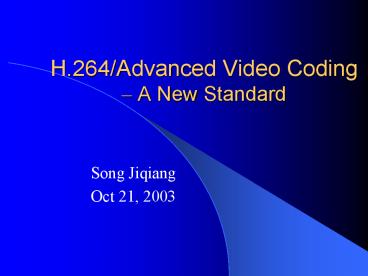H.264/Advanced Video Coding
1 / 25
Title: H.264/Advanced Video Coding
1
H.264/Advanced Video Coding A New Standard
- Song Jiqiang
- Oct 21, 2003
2
The Scope of Video Coding Standardization
- Only restrictions on the Bitstream, Syntax, and
Decoder are standardized - Permits the optimization of encoding
- Permits complexity reduction for implementability
- Provides no guarantees on quality
3
Chronological Table of Video Coding Standards
ITU-T VCEG
H.263 (1995/96)
H.263 (2000)
H.263 (1997/98)
H.261 (1990)
H.264 ( MPEG-4 Part 10 ) (2003)
MPEG-2 (H.262) (1994/95)
MPEG-4 v1 (1998/99)
ISO/IEC MPEG
MPEG-4 v2 (1999/00)
MPEG-1 (1993)
MPEG-4 v3 (2001)
1990 1992 1994 1996 1998
2000 2002 2003
4
H.261 The Basis of Modern Video Compression
- The first widespread practical success
- Milestone The first design establishes the
typical hybrid structure that dominates today. - 16?16 marcoblock motion compensation
- 8?8 DCT transform
- Variable-length entropy coding
- Operated at 64-2048 Kbps (p?64Kbps)
- Still in use
- Low complexity, low latency
- Mostly as a backward-compatibility feature
- Overtaken by H.263
5
MPEG-1 For Storage
- Five parts System, Visual, Audio, Conformance,
Reference Software - Applications VCD, VOD, Digital Camera
- Superior quality to H.261 when operated at higher
bit rates ( 1 Mbps for CIF 352x288 resolution) - Provides approximately VHS quality between 1-2
Mbps using SIF 352x240/288 resolution - Technical features Adds bi-directional motion
prediction and half-pixel motion to H.261 design - Use is fairly widespread, but mostly overtaken by
MPEG-2
6
MPEG-2 / H.262 High Bit Rate, High Quality
- MPEG-2 contains 10 parts
- MPEG-2 Visual H.262
- Not especially useful below 2 Mbps (range of use
normally 2-20 Mbps) - Applications SDTV (2-5Mbps), DVD (6-8Mbps), HDTV
(20Mbps), VOD - Support for interlaced scan pictures
- PSNR, temporal, and spatial scalability
- Profile and Level
- 10-bit precision video sampling
7
H.263 The Next Generation
- Has overtaken H.261 as dominant
video-conferencing codec - Superior to H.261 at all bit rates
- Wins by a factor of two at very low rates
- Four basic options UMV, SAC, Advanced prediction
mode, PB-frame - H.263 (1998) supports all bit rates, more
options - H.263 (2000) more options, emphasizing on
error resilience and scalability
8
MPEG-4 H.263 Additions Variable Shape Coding
- Goal Support for interactive multimedia
- Visual Object (AO), Audio Object (AO) and AVO
- Roughly follows H.263 design and adds all prior
features and (most important) shape coding - 18 video coding profiles
- Includes zero-tree wavelet coding of still
textured pictures, segmented coding of shapes,
coding of synthetic content - 2D 3D mesh coding, face animation modeling
- 10-bit and 12-bit video
- Contains 9 parts. Part 10 will be H.264
9
A Note on Terminology of H.264
- The following terms are used interchangeably
- H.26L
- The Work of the JVT or JVT CODEC
- JM2.x, JM3.x, JM4.x
- The Thing Beyond H.26L
- The AVC or Advanced Video CODEC
- Proper Terminology going forward
- MPEG-4 Part 10 (Official MPEG Term)
- ISO/IEC 14496-10 AVC
- H.264 (Official ITU Term)
10
Position of H.264
11
New Features of H.264
- Multi-mode, multi-reference MC
- Motion vector can point out of image border
- 1/4-, 1/8-pixel motion vector precision
- B-frame prediction weighting
- 4?4 integer transform
- Multi-mode intra-prediction
- In-loop de-blocking filter
- UVLC (Uniform Variable Length Coding)
- NAL (Network Abstraction Layer)
- SP-slices
12
Profiles and Levels
- Profiles Baseline, Main, and X
- Baseline Progressive, Videoconferencing
Wireless - Main esp. Broadcast
- X Mobile network
- Baseline profile is the minimum implementation
- Without CABAC, 1/8 MC, B-frame, SP-slices
- 11 levels
- Resolution, capability, bit rate, buffer,
reference - Built to match popular international production
and emission formats - From QCIF to D-Cinema
13
Basic Marcoblock Coding Structure
14
Motion Compensation
15
Multiple Reference Frames
16
B-frame Prediction Weighting
- Playback order I0 B1 B2 B3 P4 B5
B6 ... - Bitstream order I0 P4 B1 B3 B2 P8
B5 ...
17
4?4 Integer Transform
18
Intra-prediction Modes
19
In-loop De-blocking Filter
- Highly compressed decoded inter picture
- Significantly reduces prediction residuals
Without filter with H.264/AVC
De-blocking
20
SP-Slices
- Efficiently switching between two bitstreams
- Provides VCR-like functions
21
Comparison
22
Comparison
23
Summary
- Video coding is based on hybrid video coding and
similar in spirit to other standards but with
important differences - New key features are
- Enhanced motion compensation
- Small blocks for transform coding
- Improved de-blocking filter
- Enhanced entropy coding
- Substantial bit-rate savings (up to 50) relative
to other standards for the same quality - Enhancement on visual quality seems better than
that on PSNR - The complexity of the encoder triples that of the
prior ones - The complexity of the decoder doubles that of the
prior ones
24
Implementations and Implementability
- UB Video (JVT-C148) CIF resolution on 800 MHz
laptop - Encode 49 fps, Decode 137 fps
- EncodeDecode 36 fps
- Better quality than R-D optimized H.263 Profile
3 (IJKT) while using 25 higher rate and
low-delay rate control - Videolocus (JVT-D023) SDTV resolution
- 30 fps encode on P4 2 GHz with hardware assist
- Decode on P3 1 GHz laptop (no hardware assist)
- No B frames, no CABAC (approx baseline)
- DGFX SDTV, HDTV SW Encoders, Decoders and
PreProcessing - 10-12 Bit Implementation
- Others HHI, Deutsche Telekom, Broadcom, Nokia,
Motorola, NDS/Tandberg, Harmonic, LSI Logic, etc.
25
Questions?Thank you!






























